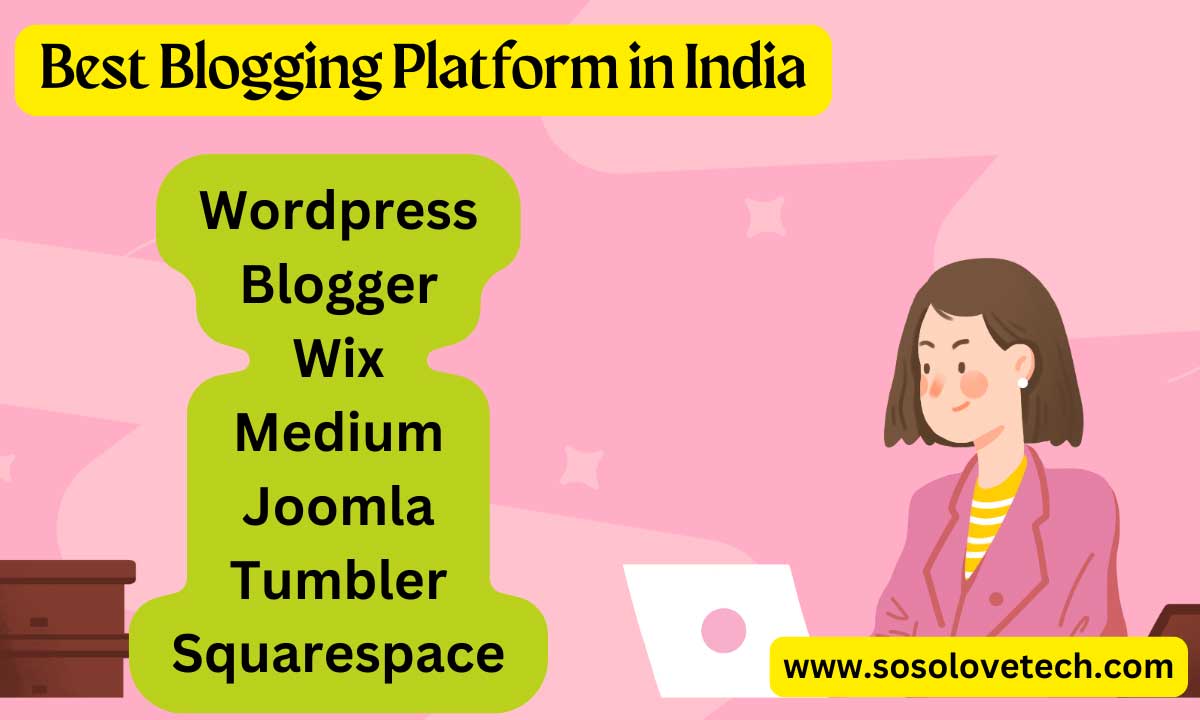Blogging continues to be a powerful medium for sharing ideas, building an audience, and even making money. Whether you’re a beginner or a seasoned blogger looking to switch platforms, choosing the right blogging platform is crucial. In 2025, several platforms stand out for their features, ease of use, and potential for growth. Here, we’ll explore the best blogging platform in India, highlighting their strengths and ideal use cases.

14 Best Blogging Platform in India in 2025
1. WordPress.org
Overview
WordPress.org remains the most popular blogging platform globally, powering over 40% of all websites. Its open-source nature allows for extensive customization, making it a top choice for bloggers who want complete control over their sites. With a massive library of plugins and themes, WordPress.org offers unparalleled flexibility and scalability.
Key Features
- Customization: Thousands of themes and plugins enable endless customization. You can create any type of website, from simple blogs to complex e-commerce sites.
- SEO-Friendly: Built-in SEO tools and plugins like Yoast SEO enhance search engine visibility, helping your content reach a broader audience.
- Scalability: Suitable for small blogs and large websites alike. As your blog grows, WordPress can handle increased traffic and additional functionality.
- Community Support: A vast community and extensive documentation provide ample support. Forums, tutorials, and professional developers are readily available to assist.
Pros
- Full control over website and data.
- Flexibility to create any type of website.
- A large community for support and resources.
- Regular updates and improvements.
Cons
- Requires some technical knowledge to set up and maintain.
- Hosting and domain costs.
- Potentially steep learning curve for beginners.
Best For
- Bloggers who want full control and customization.
- Those planning to scale their blog into a larger website.
- Developers or tech-savvy individuals comfortable with handling more technical aspects.
2. Wix
Overview
Wix is a user-friendly website builder that has gained popularity due to its drag-and-drop interface and versatile design options. It’s ideal for beginners who want a visually appealing blog without dealing with coding. Wix offers an all-in-one solution, including hosting and a range of templates.
Key Features
- Ease of Use: Drag-and-drop editor makes website building simple. You can design your site by moving elements around with a mouse, making it accessible to those without technical skills.
- Templates: Hundreds of professionally designed templates. These can be customized to fit your brand’s look and feel.
- App Market: A wide range of apps to add functionality, such as contact forms, social media integrations, and e-commerce capabilities.
- Hosting Included: Built-in hosting and custom domain options, ensuring your blog is always online without needing to manage separate hosting services.
Pros
- Intuitive interface.
- Visually stunning templates.
- All-in-one solution with hosting and support.
- Regular updates and new features.
Cons
- Limited customization compared to WordPress.org.
- Can become expensive with premium plans.
- Less control over the backend compared to self-hosted platforms.
Best For
- Beginners who prioritize ease of use.
- Bloggers who prefer a visual approach to design.
- Small businesses looking to create a professional online presence quickly.
3. Medium
Overview
Medium is a popular platform for writers and bloggers who want to focus on content without worrying about the technical aspects of running a blog. It’s a great choice for those looking to reach a built-in audience. Medium emphasizes a clean, minimalist design and a community-oriented approach.
Key Features
- Audience Reach: Access to Medium’s existing audience. Your articles can be discovered by readers already active on the platform.
- Monetization: Medium’s Partner Program allows writers to earn money based on the engagement their stories receive.
- Clean Design: Minimalist, reader-friendly design that puts the focus on your content.
- Community: Interaction with other writers and readers through claps and comments, fostering a sense of community and collaboration.
Pros
- No setup required.
- Potential to reach a large audience.
- Focus solely on writing.
- Built-in monetization options.
Cons
- Limited customization options.
- Medium controls your content and data.
- Dependence on Medium’s policies and changes.
Best For
- Writers who want to focus on content creation.
- Those seeking an existing audience.
- Bloggers who prefer not to handle technical aspects of blogging.
4. Ghost
Overview
Ghost is an open-source platform designed specifically for professional publishing. It’s known for its simplicity and speed, making it a favorite among serious bloggers and publishers. Ghost is built on Node.js, which ensures high performance and scalability.
Key Features
- Speed: Optimized for speed and performance, ensuring fast load times and a smooth user experience.
- SEO and Social Media: Built-in SEO and social media integration tools to help your content reach a wider audience.
- Membership and Subscription: Tools for monetizing through memberships, allowing you to create a subscription-based model.
- Customization: Themes and custom design options provide a balance between simplicity and flexibility.
Pros
- High performance and speed.
- Focused on professional publishing.
- Monetization options with memberships.
- Clean, distraction-free writing environment.
Cons
- Requires hosting setup.
- Less flexible compared to WordPress in terms of plugins and themes.
- Smaller community compared to other platforms.
Best For
- Professional bloggers and publishers.
- Those looking to monetize through memberships.
- Writers seeking a high-performance platform with a clean design.
5. Squarespace
Overview
Squarespace is known for its elegant designs and ease of use. It’s an all-in-one platform that includes hosting, making it a convenient choice for bloggers who want a professional-looking site without the hassle. Squarespace is particularly popular among creatives and small business owners.
Key Features
- Design: Award-winning templates and design flexibility. Squarespace’s templates are known for their aesthetic appeal and adaptability.
- E-commerce: Built-in tools for selling products and services, making it easy to add an online store to your blog.
- SEO: Basic SEO tools included to help improve your site’s visibility on search engines.
- Customer Support: 24/7 customer support to assist with any issues or questions.
Pros
- Beautiful design templates.
- User-friendly interface.
- Integrated e-commerce tools.
- Reliable hosting and support.
Cons
- Limited customization compared to WordPress.
- Higher cost for premium plans.
- Less flexibility for developers seeking to make advanced customizations.
Best For
- Bloggers who value design aesthetics.
- Those looking to integrate e-commerce features.
- Small businesses and creatives wanting a stylish, professional online presence.
6. Substack
Overview
Substack has become a popular choice for writers and bloggers who want to build a subscription-based newsletter. It’s an excellent platform for those looking to monetize their content directly from their readers. Substack combines the ease of email newsletters with the benefits of a blog.
Key Features
- Newsletter Focus: Easy creation and distribution of newsletters, allowing you to reach your audience directly in their inboxes.
- Monetization: Subscription-based model for earning income, enabling writers to charge readers for premium content.
- Analytics: Insights into subscriber behavior and engagement, helping you understand what resonates with your audience.
- Community: Connection with a dedicated audience, fostering loyalty and engagement.
Pros
- Simple setup and use.
- Direct monetization through subscriptions.
- Growing community of writers and readers.
- Ability to focus on content without managing a full website.
Cons
- Limited design customization.
- Dependence on Substack’s platform.
- Less suitable for those wanting to build a traditional blog or website.
Best For
- Writers who want to focus on newsletters.
- Those seeking to monetize their content directly.
- Bloggers looking to build a dedicated, paying audience.
7. Weebly
Overview
Weebly is another user-friendly website builder that offers a simple drag-and-drop interface. It’s suitable for bloggers who want to get started quickly without dealing with technical aspects. Weebly also provides built-in e-commerce tools, making it a versatile choice for various types of websites.
Key Features
- Ease of Use: Intuitive drag-and-drop builder that makes designing your site straightforward.
- Templates: Variety of customizable templates to choose from, catering to different styles and needs.
- E-commerce: Tools for online stores, including product listings, payment processing, and inventory management.
- Hosting Included: Built-in hosting with domain options, simplifying the process of getting your blog online.
Pros
- Simple to use.
- Integrated e-commerce capabilities.
- Cost-effective plans.
- Reliable hosting and performance.
Cons
- Limited advanced customization.
- Less flexibility compared to WordPress.
- Fewer third-party integrations.
Best For
- Beginners looking for an easy-to-use platform.
- Bloggers interested in basic e-commerce functionality.
- Small businesses needing a simple, functional website.
8. Blogger
Overview
Blogger, owned by Google, has been around for a long time and remains a straightforward platform for new bloggers. It’s free to use and integrates well with other Google services. Blogger provides a simple interface that allows users to start blogging quickly.
Key Features
- Simplicity: Easy to set up and use, making it ideal for beginners.
- Integration: Seamless integration with Google services like AdSense, Analytics, and Google Drive.
- Free Hosting: Free hosting with a Blogspot domain, providing a cost-effective way to start blogging.
- Custom Domains: Option to use custom domains for a more professional look.
- Monetization: Integration with Google AdSense allows for easy monetization through ads.
- Template Customization: Basic template customization options to give your blog a unique look.
- Google Support: Backed by Google’s infrastructure, ensuring reliability and security.
Pros
- Completely free.
- Simple interface for beginners.
- Good integration with Google tools.
- Reliable hosting with minimal downtime.
Cons
- Limited customization and features.
- Dated design options.
- Less flexibility compared to other platforms.
- Limited support for advanced SEO strategies.
Best For
- Beginners who want a free, easy-to-use platform.
- Those who don’t need advanced features.
- Bloggers looking to monetize through Google AdSense.
9. Tumblr
Overview
Tumblr is a microblogging platform that combines elements of social media with traditional blogging. It’s great for bloggers who want to share multimedia content and engage with a community. Tumblr’s community is known for its vibrant and diverse culture.
Key Features
- Multimedia: Supports text, photo, quote, link, chat, audio, and video posts, making it ideal for multimedia-rich content.
- Community Interaction: Reblogging and liking features foster community engagement and allow content to spread virally.
- Customization: Basic customization options for themes and layouts, giving some flexibility in design.
- Mobile App: Fully functional mobile app for blogging on the go.
Pros
- Easy to use and share multimedia content.
- Strong community and social features.
- Free to use.
- Great for discovering and engaging with niche communities.
Cons
- Limited advanced blogging features.
- Less professional compared to other platforms.
- Ads may appear on free blogs.
Best For
- Bloggers focusing on multimedia content.
- Those looking for a social community aspect.
- Hobby bloggers and creative individuals.
10. Joomla
Overview
Joomla is an open-source content management system (CMS) that offers robust features and flexibility. It’s less popular than WordPress but provides a strong alternative for those seeking more control and customization.
Key Features
- Flexibility: Extensive customization options with thousands of extensions and templates.
- User Management: Advanced user management capabilities, making it suitable for membership sites and large-scale operations.
- Multilingual Support: Built-in multilingual support for creating content in multiple languages.
- SEO Tools: SEO-friendly features to enhance search engine visibility.
Pros
- Powerful and flexible.
- Strong community support.
- Suitable for complex websites with multiple users.
- Robust security features.
Cons
- Steeper learning curve compared to WordPress.
- Requires technical knowledge for setup and maintenance.
- Smaller community and fewer themes/plugins than WordPress.
Best For
- Advanced users who need extensive customization.
- Developers and businesses requiring complex websites.
- Those looking for a strong alternative to WordPress.
11. Drupal
Overview
Drupal is another open-source CMS known for its robustness and flexibility. It’s favored by developers and large organizations for its scalability and security.
Key Features
- Customization: Highly customizable with thousands of modules and themes.
- Scalability: Handles large volumes of traffic and complex websites.
- Security: Strong focus on security, making it a choice for government and enterprise websites.
- Multilingual Capabilities: Built-in support for creating multilingual websites.
Pros
- Extremely flexible and powerful.
- Suitable for large-scale websites and applications.
- Strong community support.
- Excellent security features.
Cons
- Requires a high level of technical expertise.
- Steep learning curve.
- More time-consuming to set up and manage.
Best For
- Developers and technical users.
- Large organizations and enterprises.
- Websites requiring advanced security and scalability.
12. HubSpot CMS
Overview
HubSpot CMS is a premium content management system integrated with HubSpot’s marketing, sales, and service tools. It’s designed to help businesses create and manage content efficiently while leveraging marketing automation features.
Key Features
- Integration: Seamless integration with HubSpot’s CRM and marketing tools.
- Personalization: Advanced personalization features to tailor content to different audience segments.
- SEO Tools: Built-in SEO recommendations and tools to optimize content.
- Drag-and-Drop Editor: User-friendly interface for easy content creation and design.
Pros
- Comprehensive marketing and sales integration.
- User-friendly interface.
- Advanced analytics and reporting.
- Excellent customer support.
Cons
- Expensive compared to other platforms.
- Limited customization compared to open-source CMS.
- May be overkill for simple blogs.
Best For
- Businesses looking for an integrated marketing and CMS solution.
- Marketers who want to leverage advanced automation features.
- Medium to large enterprises.
13. Typepad
Overview
Typepad is a paid blogging service known for its simplicity and ease of use. It’s been around since 2003 and offers a reliable platform for professional bloggers and businesses.
Key Features
- Ease of Use: Simple, user-friendly interface.
- Design Options: Customizable themes and templates.
- SEO Tools: Built-in SEO tools to help improve search engine rankings.
- Support: Reliable customer support and hosting.
Pros
- Easy to set up and use.
- Reliable performance and uptime.
- Professional themes and templates.
- Good customer support.
Cons
- Paid service with no free option.
- Limited customization compared to WordPress.
- Fewer integrations and plugins.
Best For
- Professional bloggers looking for a reliable platform.
- Businesses needing a simple, straightforward blogging solution.
- Users who prefer a managed service.
14. Webflow
Overview
Webflow is a web design tool, CMS, and hosting platform all in one. It’s known for its flexibility and powerful design capabilities, making it a favorite among designers and developers.
Key Features
- Design Flexibility: Advanced design tools for creating custom, responsive websites.
- CMS: Robust content management system for handling blogs and dynamic content.
- E-commerce: Integrated e-commerce capabilities for selling products and services.
- Hosting: Fast, reliable hosting included with the platform.
Pros
- Highly flexible and customizable.
- Powerful design and animation tools.
- Integrated CMS and e-commerce features.
- Excellent performance and uptime.
Cons
- Steep learning curve for beginners.
- More expensive than other platforms.
- Requires design and development skills for full utilization.
Best For
- Designers and developers seeking advanced design capabilities.
- Businesses needing custom, high-performance websites.
- Those looking to combine CMS and e-commerce in one platform.
Conclusion
Choosing the best blogging platform in India depends on your specific needs, technical expertise, and goals. WordPress.org offers unparalleled customization and control, making it ideal for serious bloggers. Wix and Squarespace provide user-friendly interfaces and beautiful designs, perfect for beginners. Medium and Substack are excellent for writers focusing on content creation and audience engagement. Ghost is tailored for professional publishers, while platforms like Blogger and Tumblr offer simplicity and social interaction.
For more advanced users and businesses, platforms like Joomla, Drupal, and HubSpot CMS offer robust features and integrations. Typepad and Webflow cater to professional bloggers and designers seeking reliable and customizable solutions.
When selecting a platform, consider factors such as ease of use, customization options, scalability, and monetization opportunities. With the right platform, you can create a successful blog that meets your needs and grows with you. Happy blogging!

